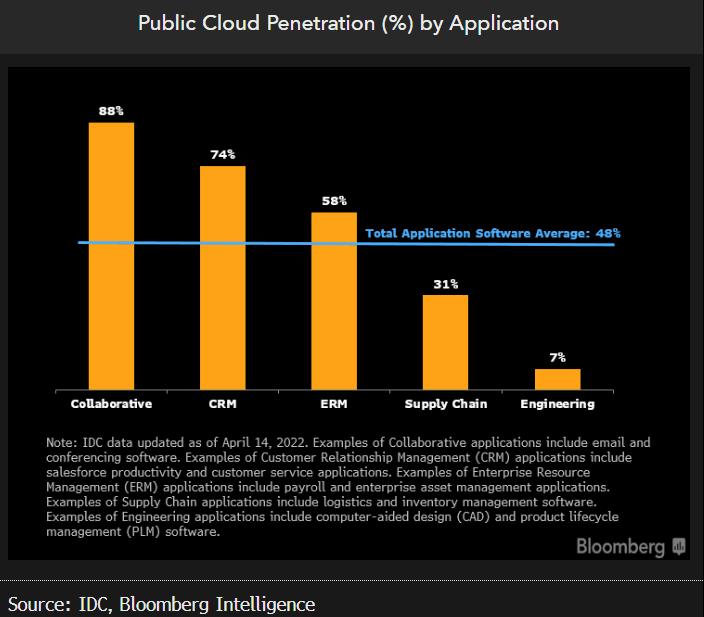This analysis is by Bloomberg Intelligence Senior Industry Analyst Eileen Segall and Bloomberg Intelligence Associate Analyst Maria Fernanda Beltran Fuentes. It appeared first on the Bloomberg Terminal.
Autodesk has an extended path to increase sales if it executes well in its shift to the cloud, a market expanding over 20%. Just 7% of engineering-software sales come from products hosted in the public cloud, underscoring the opportunities. The majority of engineering-software products are still used on-premise.
Cloud underpenetrated in engineering software
Products hosted on the public cloud represent only 7% of engineering-software companies’ revenue, highlighting the untapped opportunities for Autodesk and rivals. This small percentage contrasts with customer relationship management (CRM) and collaborative-software companies, like Zoom, which generate more than 70% of sales from public-cloud-hosted products, and an average of 48% for the overall application-software market, based on IDC data.
Autodesk generated just 8% of revenue from cloud-based subscriptions in fiscal 2022, and its sales growth should benefit if the company competes well in the market’s transition to the cloud.

Cloud offers growth, machine learning
The benefits to Autodesk of offering cloud-based products could include greater customer satisfaction and revenue growth. Demand for cloud-based engineering software can be seen in the 24% compound annual growth rate (CAGR) in sales for products hosted on the public cloud vs. 8% for on-premise and other software.
Demand is fueled by a better user experience, including access from any device and easier multi-user collaboration. Cloud-based software-as-a-service (SaaS) can also reduce the burden on customers to maintain servers and other IT overhead, may be more secure, is easier to update, and offers real-time user data that machine learning can use to improve analytics.

Subscription transition complete; cloud in process
Subscriptions are 95% of sales after Autodesk shifted away from selling one-time perpetual license and maintenance contracts in fiscal 2014. Its software, however, is mostly used on-premise and there’s still a large opportunity to move to a cloud-based SaaS model from on-premise subscriptions. Autodesk has moved to the cloud mostly through a hybrid approach with its 360 line of products, hosted by Microsoft Azure and Amazon AWS. Revit, for example, can be connected to BIM 360 so users can collaborate on a building model shared online. Autodesk Platform Services (previously Forge) allows developers to tie their third-party software via APIs to its 360 products.
Autodesk is also developing three industry-specific cloud platforms: Forma for AEC, Fusion for manufacturing, and Flow for media and entertainment.
